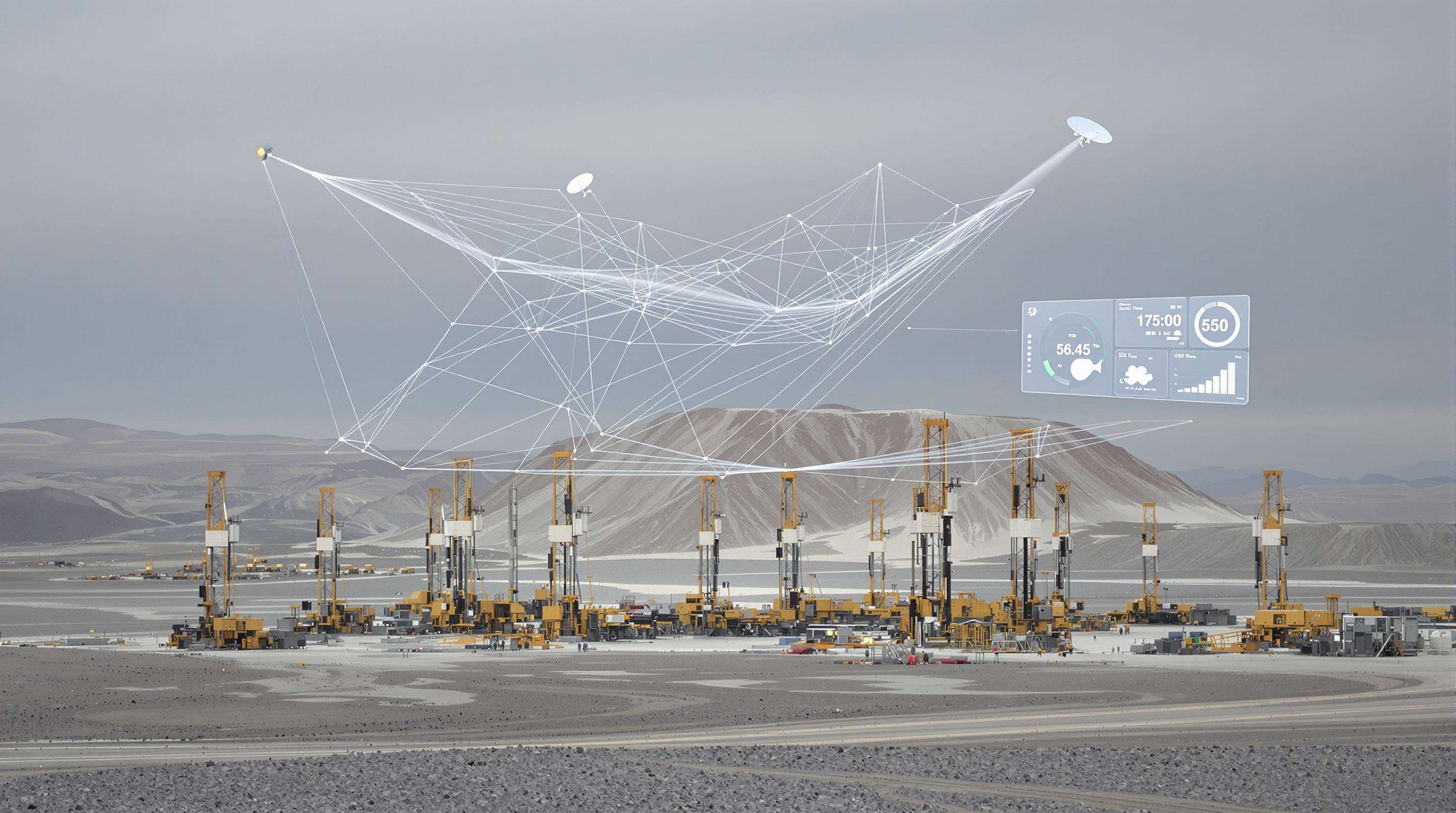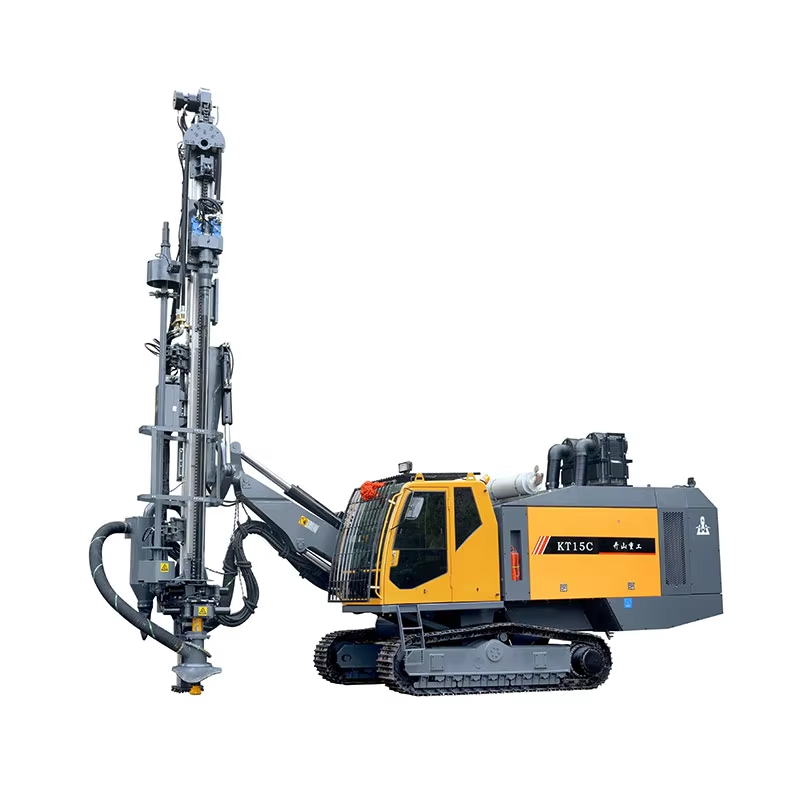DTH Drill Rig Automation and Digital Transformation

AI-driven drilling pattern optimization systems
Artificial Intelligence in modern Down-the-Hole (DTH) drill rigs perception is enabling optimal drilling patterns on-the-fly. Geological data is processed through algorithms to self-regulate penetration rates, percussion pressure and rotation speeds by real-time analysis of rock hardness. The system eliminates guesswork in hand targeting, resulting in an 18-22% reduction in bit wear and increased ROP. Systems respond to dynamic subsurface conditions (e.g. fractured zones or abrasive beds) ensuring optimal performance no matter the complexity. According to a study from Mining Magazine Intelligence, AI-enabled rigs delivers a 15-25% higher feet per hour rate in hard rock conditions.
Integration of IoT sensors for real-time feedback
Sensors in the hammers, drill collar and compressor transmit live operation data online. Vibration, pressure, temperature, and flow data are sent via cloud to central dashboards. The vibration data is transmitted to drillers in real time and the system also sends alerts for any anomalies such as air-loss spikes or excessive hammer friction, allowing proactive correction before failures happen. This sensor fusion reduces unscheduled downtime by 30% and enhances borehole accuracy with millimetric tracking of the trajectory in all drilling phases.
Case study: 32% efficiency gains at Chilean copper mine
Helping a South American copper mine To improve productivity, we worked with them to combine pattern optimization of AI with feedback from the IoT at a Chilean copper operation. This automated machine lowered average drilling time per hole from 45 to 31 minutes and resulted in a 27% longer bit life. Together with predictive maintenance from vibration sensor alarms, overall equipment effectiveness improved by 32% within 6 months. This resulted in an additional 19 meters drilled per shift and an annual savings of over $740 k, demonstrating digital transformation’s impact on ROI.
Intelligent Control Systems in Modern DTH Rigs
Adaptive pressure regulation technology
DTH drill rigs have integrated intelligent pressure systems which can dynamically change hydraulic forces in response to immediate geological information. These microprocessor-controlled devices rapidly adjust percussion intensity in milliseconds according to changes in rock density. Unlike static equipment, it stays at best pressure as the subsurface shifts, so you avoid both under-penetration and equipment stress fractures. Field results show 23% faster drilling rate of penetration (ROP) with less component fatigue in sudden changes in hardness, confirming this technology as a necessity in hard inter-bedded formations.
Machine learning for rock hardness analysis
State-of-the-art boring machines are currently using neural networks to interpret vibrational signatures indicating strata composition as they drill. The algorithms use impact echoes from thousands of reference wave forms to estimate the compressive strength with ≥94% accuracy. Using real-time telemetry to compare with a geological database, this system self-adjusts the drilling parameters with no operator interaction. This AI-based detection greatly reduces the chance for early bit wear triggered by the improper application of force in unforeseen quartz layers or soft bands.
Controversy: Operator skill vs automated decision-making
Ongoing industry discussion disputes if optimization algorithm can replace humans in difficult decisions. However, automatic DTH-controls improve the accuracy of regular drill patterns, but the decision situation of the control during undocumented anomalies, here fault lines, and aggregates of other compositions produce weak responses. Several tunneling projects show that it is 17% more efficient to override automated protocols in chaotic formations by experienced operators. This evidence strongly supports the case for balanced systems that combine algorithmic precision with operator judgement.
DTH Drill Rig Fleet Management Revolution

Satellite-connected monitoring platforms
Today's fleet management uses satellite-connected Internet of Things (IoT) networks to track 150+ working parameters on multiple rigs at the same time. These systems send drill depth, air pressure, and component wear rates to centralised dashboards with <300ms latency that allow supervisors to optimise operations from remote locations. Analysis done for that sector also projected that deployments will reduce the average number of unplanned downtime hours by 27% through real-time torque adjustments and collision avoidance alerts in 2023. Key capabilities include:
- Multi-spectral terrain mapping integration
- Automated shift scheduling based on fatigue sensors
- Dust suppression system activation during sensor-detected airflow changes
Predictive maintenance algorithms
Currently, machine-learning models with the capability to process 18 months of historical performance data are now able to predict hammer seal failures at an accuracy level of 92%, 48-72 hours before a complete catastrophic failure happens. This changes the focus of maintenance from calendar-based inspections to condition-based interventions and lengthens the average bit life to 9,200 drilling hours (+34% compared to reactive methods). Field studies have shown a 38% reduction in hydraulic system overhauls where:
- Vibration pattern analysis predicting bearing wear
- Thermal imaging algorithms detecting airflow blockages
- Adaptive lubrication schedules based on rock abrasion metrics
These systems prioritize repairs by criticality, allocating parts and technicians to maximize fleet availability rather than individual rig uptime.
Component Innovations in DTH Drilling Systems
Advances in the engineering of DTH drill components have had a direct effect on the efficiency of DTH drilling and on jobsite costs. State-of-the-art material science and hydrodynamic redesigns solve key failure points and significantly increase service intervals during the useful life of the compressor with limited maintenance interruptions. Decades of development have led to several key innovations throughout the critical drill string components – from impact mechanisms to material make-up – necessary to successfully operate in ultra-hard rock formations where conventional drill string components prematurely fail.
Tungsten-carbide hammer improvements (12,000+ hour lifespan)
Advanced metallurgy provides longer life during high impact clinker cured solids life and now superior to 12,000 hours triple standard iron ore component life. Game-changing data and analysis. Laser sintering produces crack-free microstructures and boride coatings reduce the degree of wear by abrasion at higher penetration rates over 40 meters/hour. This lowers hammer change-out by 62% in quarry drilling and results in $28k per rig annual savings.
Anti-jamming bit design advancements
Revolutionary asymmetrical flute shapes prevent rock re-circulation – the leading cause of jamming in fractured formations. CFD models the helical channels ensure effective evacuation of upflow pressure 25 bar with minimal air loss. Field trials in Australian iron formations have demonstrated an 88% decrease in downtime events while the tapered stabilizer fins prevent the lateral vibration that historically led offkilter boreholes.
Lightweight alloy material applications
The new drill rods are 40% lighter than steel and provide an equivalent torsional stiffness, but that reduces weight now – the deeper the hole, the lighter the rod (with no need for energy-consuming j coupling adapters). You don't have to look far to find innovative powertrain systems. Too often, though, they fall short of industry's expectations: they weigh too much, cost too much, and take too long to develop. And drilling is a very big job in the Hot, Flat and Now world of urbanization, information… Compression Systems president John Lewis. Among the benefits that may result are the ability to cycle down hole with 650°C heat, the capability of reaming and drilling at the surface with lot more pressure (up to 50,000 psi) and pressure pulse capabilities tested to 40,000 psi. Petroleum consumed decreased by 1.5 gasoline gallon equivalent in Thanks to Dr. OPT. CATEGORY: Best-in-Class Mobile EDUGAMES Visit our site to find the winners Back in the days when the rear view was dim, The newest, biggest thing in compression is not a compressor at all - it's a frack pump. A new interstage seal design dispatches low-pressure process gas that enters the second stage, This article, entitled "Compliance and Beyond," examines how current and proposed DoD cybersecurity directives are forcing DoD contractors to rethink their cybersecurity strategy, starting with better management of their cybersecurity measures. Field application in rolling mountain operations also reduced fuel consumption by 17% after extending the residual life of the casing thread in the presence of lower fatigue stresses.
Sustainable DTH Drill Rig Operations
Hydraulic energy recovery systems saving 18-22% fuel
The next generation of DTH rigs captures kinetic energy in the deceleration phase of the vehicle through closed-loop hydraulics and turns excess movement into useful power. Field testing has demonstrated that these systems reduce drilling cycle diesel consumption by 18-22%, compared to conventional installations. The energy transfer rate can be automatically regulated according to the real-time workload, and the energy conversion efficiency can be as high as 93% in granite formations.
Low-noise drilling head developments
Helical sound attenuators on these new generation drill heads reduced operating noise by 14-19 dB(A) depending on the type of rock. A 2024 geotechnical land-based equipment survey at 15 m distance recorded 67 dB – equivalent to urban traffic – opening up the option of using the rig for night time urban piling where limits on noise exist. These designs retain 98% of the conventional sound absorptive muffler; sound absorption first enters a smaller absorption chamber through a low-restriction flow path, as sound waves flow into this chamber they expand, necessitating expansion into a larger absorption chamber - the flow transitioning into a much broader absorption chamber, where a unique combination of louvered tubes, perforated tubes, and most importantly, long sound absorbing fiber is textile-wrapped.
Biodegradable drilling fluid innovations
So much plant-based rheology modifier now subs in for 70-85% of good old bentonite clay in drilling fluids that we trash 90% of it while they take 8-10 years to degrade ours sits beaten up like this after only 6 months. Independent laboratory testing verifies that these nontoxic formulations retain the appropriate viscosity up to 140°C and remove the risk of contamination from heavy metals. Their shear-thinning characteristics increase shale cuttings' cleaning efficiency by 22% vs. drilling fluid.
DTH Drill Rigs in Geothermal Applications
Modified rigs for shallow heat extraction
Specialised DTH drill rigs are able to access the shallow reservoirs economically efficient. These rigs are provided with a compact design and a precision percussion system engineered for sedimentary strata, usually in depths between 500 and 1500 meters. The low impact of their operations reduces surface disruption – an important consideration in developed areas, yet they penetrate 15 – 25% faster than other drilling techniques typically used in geothermal applications. "Repulse" hammer assemblies and pneumatic cooling means preclude thermal destruction under continuous duty at volcanoes.
Enhanced casing installation techniques
Casing of present-day geothermal wells employs flexible couplings and a grouting compound which reacts to fill cracks and to accommodate moving rock due to temperature change. It utilises tapered steel-alloy casings which are driven in with precision DTH percussion to save 30 per cent of installation time and provide long-term borehole protection in corrosive conditions. Such casing systems can resist up to 300°C without changing their structure which is not the case of liners, for avoiding a pollution of resource and a heat loss.
FAQ
What is the role of AI in DTH drill rig operations?
AI in DTH drill rig operations helps in optimizing drilling patterns by processing geological data and self-regulating variables like penetration rates and percussion pressure based on rock hardness.
How do IoT sensors enhance the functionality of DTH drills?
IoT sensors in DTH drills provide real-time feedback, transmitting live operation data that helps detect anomalies early, reduces unscheduled downtime, and improves borehole accuracy.
What advantages do modern DTH rigs offer in geothermal applications?
Modern DTH rigs in geothermal applications provide economic efficiency, faster penetration in specific depths, and reduce surface disruption, making them ideal for developed areas and volcanoes.

